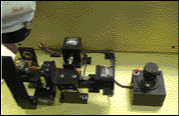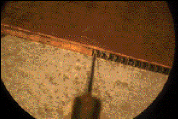Michael Feygin and Robert Geminder
Although the general slump of the telecommunications sector continues, many companies in the fiber optics industry require solutions for automating their processes as insurance for their survival. Current production volumes do not justify the expense of fully automated systems, and the unstable production requirements of today's market further complicate the matter.

The laser diode array analyzer is a semiautomated workstation for the testing of arrays of vertical-cavity surface-emitting lasers.
Multiple, inexpensive modules for automation provide more flexibility to their users and make more sense in today's market than a fully automated system. This can be done with semiautomated workstations that deliver "hands-on" automation.
An example of such a system is the laser diode array analyzer from Stereoniks Automation of Carson, Calif. The company designed and built the analyzer to help a manufacturer of vertical-cavity surface-emitting laser (VCSEL) arrays automate its testing process. The customer required a station that could test the optical output vs. applied current for an array of up to 100 VCSELs within a couple of minutes.

The user of the system defines the location of the first and last laser in the array and the number of units. The system then automatically moves an electric needle probe through three axes to address the individual lasers.
The analyzer features a vacuum chuck for supporting and holding a linear array of up to 100 units. A closed-loop-controlled heater under the base of the array provides temperatures of up to 100 °C. The output characteristics of VCSELs depend on their temperature, and tests thus need to be performed at the temperature of their working environment. A computer-driven stage positioning in three axes holds the vacuum chuck and the heater.
In operation, the analyzer automatically directs an electric needle probe in three axes to touch each laser and to capture the optical power vs. current data in tabular and graphical forms. The electrical probe provides to each laser of the array a scanning electrical signal ranging from 0 to 200 mA.
The operator uses a joystick to move the first and last VCSELs of the array into contact with the probe and inputs the number of lasers in the array into the computer, which uses this information to calculate the required X-Y-Z motion of the system with submicron resolution. After a user-initiated start signal, the system's software automatically moves each laser so that it contacts the needle probe, and then initiates the necessary electrical current. Once a laser starts emitting, the optical sensor captures and transmits the optical power information to the computer, which records the captured data in the log file along with the values of the corresponding currents.
One feature of the analyzer is its ability to display onscreen the graphs of the optical power vs. current for individual lasers, a test that is performed as part of the quality-control procedure during acceptance of the finished product. A custom computer interface for optical power data acquisition was developed for the system to enable the operator to select the number of lasers in the array and the range of intervals for the current scan. The computer stores the output curves for the tested lasers to facilitate future analysis and calculates factors such as the slope of the optical power curve and the values at control points to identify bad lasers in the batch.
The analyzer enables a threefold increase in productivity for the client. The client also anticipates more reliable quality control because objective measurements from the computer determine rejects, rather than subjective analysis by a human.
Neither the production volume nor the available budget justified an investment in a fully automated system, so the step toward semiautomated operation was the right one for this user. It may be a wise approach for many other companies.